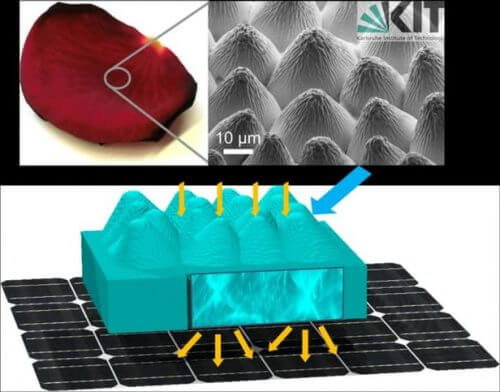Researchers have found inspiration in the structure of rose petals to improve the efficiency of solar panels

By: Ofir Marom
In the process of photosynthesis in plants, the energy that comes from the sun is absorbed by the surface of the plant, and converted into a new form of energy. A similar thing happens in the photovoltaic process, where the sun's radiation hits a solar panel and turns it into electrical energy. As in the process of photosynthesis in plants, the goal in solar panels is to use the same energy with maximum efficiency. To do this, you need to use a wide range of the spectrum of sunlight, as well as be able to capture the light when it comes from different directions during the movement of the sun throughout the day. Therefore, it only makes sense for scientists to look to nature for inspiration for new solar panel design ideas.
Researchers at KIT University in Germany did exactly that. First, they studied the ability of the surface of various plants to absorb and reflect the light rays that hit them. The petals of rose flowers stood out with a high ability to absorb light, and were therefore chosen as good candidates for further research. In a thorough examination of the petals under an electron microscope, it was found that the cells of the epidermis, the surface of the petals, are covered with microscopic projections in great density but without any particular order. The bumps themselves were not smooth, but were also randomly covered with nanometric ribs. The researchers hypothesized that the characteristic shape of the surface is related to the petals' high ability to absorb light. In the next step, the researchers decided to examine whether it is possible to copy this pattern artificially for the coating of solar panels. To do this, the petals were coated with a silicon-based polymer. After the polymer solidified, a mold was created, into which the researchers poured an optical glue that hardened when exposed to UV radiation. At the end of the process, a thin film was obtained, which is an exact copy of the surface of the petals.
The film was placed on top of a solar panel that underwent a series of performance tests. At the end of the tests, it was found that the film created by the researchers improved the panel's electricity generation efficiency by 12% when the light hit the panel at a right angle, while when the light hit the panel from the side (at an 80 degree angle) the film improved the efficiency by 44%!. The research showed that the bumpy structure on the surface of the petals helps to focus the incoming light and direct it deep into the surface, where it becomes a new type of energy. The quest to develop an efficient technology, which will make it possible to turn as much of the solar energy into electrical energy as possible, is occupying many researchers around the world. Many of the existing solutions are too expensive to become commercial. Today, in practice, solar panels work with an efficiency of only a few tens of percent on average (the world record is 34.5%). The addition obtained by covering the panels with a layer that imitates the mechanism of the petals is an elegant and relatively simple solution for producing more energy from the current technology.
Source of knowledge

3 תגובות
A genius idea to find inspiration in flowers, it makes sense that the surface is not smooth and rough will absorb more light at different angles and absorb more energy into the panel. What the panel is made of is another matter
About 10 years ago, a silicon-based solar panel called Black Silicon was developed, the surface structure is exactly the same with higher roasts. The scientific work is very beautiful and suitable for other projects, but from here to an efficient solar panel the distance is great. The Black Silicon also utilizes the low infrared range. Not here.
What I don't understand is whether they don't see the work of other scientists and check if the technology can be integrated into more advanced panels.
Of course, after the publication, we will check whether the technology is suitable for our panels that we developed, which currently reach 34% in the laboratory. (The announcement of the achievement will be in about a year).
I haven't read the original publication, but I wonder if the improvement is measured against a smooth panel or against a panel with a different antireflective coating.